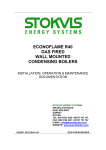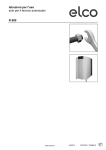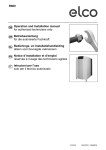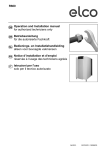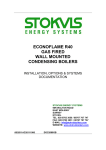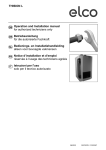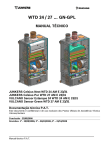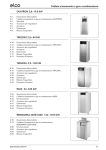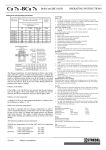Download Commissioning - Stokvis Industrial Boilers International Ltd
Transcript
ECONOFLAME R6000 LMS GAS FIRED CONDENSING BOILERS INSTALLATION,OPERATION & MAINTENANCE DOCUMENTATION STOKVIS ENERGY SYSTEMS 96R WALTON ROAD EAST MOLESEY SURREY KT8 0DL TEL: 020 87833050 / 08707 707 747 FAX: 020 87833051 / 08707 707 767 E-MAIL: [email protected] WEBSITE: www.stokvisboilers.com DOC3070 R6000 BA Contents 2 Contents .................................................................. 2 Safety General regulations ................................... Application ................................................. Norms and regulations .............................. 3 3 3 Construction Layout of boiler .......................................... Operating principle .................................... 4 4 Technical data .................................................................. 5 Extent of delivery Standard boiler .......................................... Accessories ............................................... 7 7 Installation Boiler transport .......................................... Removing the casing ................................. Boiler installation ....................................... Connecting the boiler ................................ 8 9 10 11 Commissioning Water and hydraulic system ...................... Gas supply ................................................ Condensate connection ............................. Flue and air intake connections ................. Prepare boiler for first startup .................... Combustion analysis ................................. Check water flow ...................................... Check functionality of safety devices ........ Gas tightness check .................................. Boiler shut down ........................................ Commissioning protocol ............................ 13 14 14 14 15 16 17 18 18 18 19 Operating instructions Controls .................................................... Display / Programming .............................. Overview of main functions ....................... 20 21 22 Maintenance Checklist .................................................... Replacing the electrodes ........................... Cleaning the condensate receptacle ......... Cleaning and refilling the syphon .............. Inspection of combustion chamber ............ Water pressure and quality ....................... Water flow rate .......................................... Combustion analysis ................................. Gas pressure ............................................. Gas tightness check .................................. Safety devices ........................................... Maintenance protocol ................................ 23 23 24 24 24 25 25 25 25 25 25 26 Lockouts .................................................................. 27 Sensor values .................................................................. 30 Declaration of Conformity .................................................................. 31 Safety General regulations Application Norms and regulations General regulations This documentation contains important information, which is a base for safe and reliable installation, commissioning and operation of the R6000 boiler. All activities described in this document may only be excecuted by authorized companies. Changes to this document may be effected without prior notice. We accept no obligation to adapt previously delivered products to incorporate such changes. Only original spare parts may be used when replacing components on the boiler, otherwise warranty will be void. Application The R6000 boiler may be used for heating and hot water production purposes only. The boiler should be connected to closed systems with a maximum temperature of 100ºC (high limit temperature), maximum setpoint temperature is 90ºC. Norms and regulations When installing and operating the boiler, all applicable norms (european and local) should be fulfilled: Local building regulations for installing combustion air and flue gas systems; Regulation for connecting the boiler to the electrical appliance; Regulations for connecting the boiler to the local gas network; Norms and regulations according to safety equipment for heating systems; Any additional local laws/regulations with regard to installing and operating heating systems. The R6000 boiler is CE approved and applies to the following European standards: 92 / 42 / EEC Boiler efficiency directive 2009 / 142 / EEC Gas appliance directive 73 / 23 / EEC Low voltage directive 2004 / 108 / EEC EMC directive EN 656 Gas-fired central heating boilers – Type B boilers of nominal heat input exceeding 70 kW but not exceeding 300 kW EN 15420 Gas-fired central heating boilers Type C boilers of nominal heat input exceeding 70 kW, but not exceeding 1000 kW EN 15417 Gas-fired central heating boilers Specific requirements for condensing boilers with a nominal heat input greater than 70 kW but not exceeding 1000 kW EN 13836 Gas fired central heating boilers Type B boilers of nominal heat input exceeding 300 kW, but not exceeding 1000 kW EN 15502-1 Gas-fired central heating boilers Part 1: General requirements and tests EN 55014-1 (2000) Electromagnetic compatibility - Requirements for household appliances, electric tools and similar apparatus Part 1: Emission EN 55014-2 (1997) Electromagnetic compatibility - Requirements for household appliances, electric tools and similar apparatus Part 2: Immunity - Product family standard EN 61000-3-2 (2000) Electromagnetic compatibility (EMC) Part 3-2: Limits - Limits for harmonic current emissions (equipment input current 16 A per phase) EN 61000-3-3 (2001) Electromagnetic compatibility (EMC) Part 3-3: Limitation of voltage changes, voltage fluctuations and flicker in public low-voltage supply systems, for equipment with rated current 16 A per phase and not subject to conditional connection EN 60335-1 (2002) Household and similar electrical appliances - Safety - Part 1: General requirements EN 60335-2-102 (2006) Household an similar electrical appliances: Particular requirements for gas, oil and solid-fuel burning appliances having electrical connections Additional national standards Germany: RAL - UZ 61 / DIN 4702-8 Switzerland: SVGW EKAS-Form. 1942: FlüssiggasRichtlinie Teil 2 Vorschriften der kantonalen Instanzen (z.B. Feuerpoilizeivorschriften) Netherlands: GASKEUR BASIS GASKEUR SV GASKEUR HR107 Belgium: HR TOP 3 Construction Layout of boiler Operating principle 1 5 4 2 7 6 Layout of boiler The R6000 boiler consists of the following main components: 1 2 3 4 5 6 7 8 9 10 11 12 13 14 3 8 14 13 24 22 15 Operating principle The R6000 is a fully modulating boiler. The control unit of the boiler adapts the modulation ratio automatically to the heat demand requested by the system. This is done by controlling the speed of the fan. As a result, the Whirlwind mixing system will adapt the gas ratio to the chosen fan speed, in order to maintain the best possible combustion figures and therewith the best efficiency. The flue gases created by the combustion are transported downwards through the boiler and leave at the back side into the chimney connection. 4 23 16 12 9 18, 19, 20, 21 17 10 25 15 16 17 18 19 20 21 22 23 24 25 Casing Front panel Adjustable feet Control panel (below cover) Flue gas connection Air intake connection (under casing) Gas connection Flow water connection Return water connection 2nd (hot) return water connection (for split system use) Filling/draining valve Electrical input connections Frame Burner/1st heat exchanger assembly 2nd/3rd heat exchanger assembly Water headers Condensate receptacle Whirlwind gas/air mixing system Fan Gas valve Gas pressure switch Inspection opening Ignition and ionisation electrodes Syphon Removable flue gas adapter 11 The return water from the system enters the boiler in the lower section, where is the lowest flue gas temperature in the boiler. In this section condensation takes place. The water is being transported upwards through the boiler, in order to leave the boiler at the top (burner) section. The cross flow working principle (water up, flue gas down) ensures the most efficient combustion results. The LMS14 control unit can control the boiler operation based on: Boiler control (stand alone operation); Weather compensated operation (with optional outdoor sensor); With 0-10V external influence (temperature or capacity) from a building management system. Technical data R6142 R6190 R6237 R6285 R6380 R6475 R6539 Nominal heat output at 80/60ºC max/min* kW 142.1/23.3 190.1/39.5 237.2/39.5 285.2/39.5 380.2/76.6 475.3/76.6 539.0/76.6 Nominal heat output at 75/60ºC max/min* kW 142.2/23.5 190.3/39.5 237.4/39.5 285.5/39.5 380.6/76.6 475.8/76.6 539.6/76.6 Nominal heat output at 40/30ºC max/min* kW 150.7/26.7 201.6/45.2 251.4/45.1 302.3/45.2 403.1/87.7 503.9/87.7 571.5/87.7 Nominal heat input Hi max/min* kW 145.0/24.5 194.0/41.5 242.0/41.5 291.0/41.5 388.0/80.5 485.0/80.5 550.0/80.5 Efficiency at 80/60ºC % 98.0 Efficiency at 40/30ºC % 103.9 Annual efficiency (NNG 75/60ºC) % 106.8 Annual efficiency (NNG 40/30ºC) % Standstill losses (Twater = 70ºC) % 0.21 0.18 0.17 0.16 0.15 0.14 Max. condensate flow l/h 11 15 19 22 30 37 42 Gas consumption H-gas max/min (10,9 kWh/m3) m3/h 13.3/2.3 17.8/3.8 22.2/3.8 26.7/3.8 35.6/7.4 44.5/7.4 50.5/7.4 Gas consumption L-gas max/min (8,34 kWh/m3) m3/h 17.4/2.9 23.2/5.0 29.0/5.0 34.9/5.0 46.5/9.7 58.2/9.7 66.0/9.7 Gas consumption LL-gas max/min (8,34 kWh/m3) m3/h 17.4/2.9 23.2/5.8 29.0/5.8 34.9/5.8 46.5/11.2 58.2/11.2 66.0/11.2 Gas consumption LPG. max/min (12,8 kWh/kg) kg/h 11.3/1.9 15.2/3.2 18.9/3.2 22.7/3.2 30.3/6.3 37.9/6.3 43.0/6.3 Gas pressure H-gas mbar Gas pressure L/LL-gas mbar 25 Gas pressure LPG mbar 30/50 Maximum gas pressure mbar 100 ºC 78/61 636/134 795/134 901/134 Flue gas temperature at 80/60ºC max/min Flue gas temperature at 40/30ºC max/min Flue gas quantity max/min* CO2 level natural gas H/E/L/LL max/min CO2 level liguid gas P max/min 110.4 20 ºC m3/h 56/30 238/40 318/69 397/69 477/69 % 10.2/9.4 % 11.9/10.0 NOx level max/min mg/kWh 35/15 CO level max/min mg/kWh 14/8 Max. permissible flue resistance max/min Water volume 0.13 Pa 160/10 160/10 200/10 200/10 200/10 250/10 250/10 l 27 31 35 61 68 75 82 bar 8/1 Max. water temperature (High limit thermostat) ºC 100 Maximum temperature setpoint ºC Nominal water flow at dT=20K m3/h 6.1 8.1 10.2 12.2 16.3 20.4 23.1 Hydraulic resistance at nominal water flow kPa 10 18 28 15 27 42 55 Water pressure max/min 90 Electrical connection V 230/400 50 Frequency Hz Mains connection fuse A 16 IP class - IP20 Power consumption boiler max/min (excl. pump) W 158/43 200/35 230/35 260/35 470/61 650/61 770/61 Power consumption 3-step pump (optional) W 170/90 190/120 380/210 380/210 530/300 720/380 1150/600 Power consumption speed controlled pump (opt) W 180/10 180/10 435/25 435/25 450/25 800/35 800/35 Power consumption bypass pump (optional) W 55/35 85/65 170/90 170/90 190/120 460/225 470/280 kg 295 345 400 465 535 590 650 Weight (empty) Noise level at 1 meter distance Ionisation current minimum dB(A) 59 µA 6 PH value condensate - 3.2 CE certification code - Water connections - CE-0063BS3840 R2" DN65 PN16 - R3/4" R1" R1" R1" R1.1/2" R1.1/2" R1.1/2" Flue gas connection mm 150 150 200 200 250 250 250 Air intake connection (for room sealed use) mm 130 150 150 150 200 200 200 Condensate connection mm 40 40 40 40 40 40 40 Gas connection * min load on gasses H/L/LPG. For type R6237-R6539 on gasses LL-Gas min value is 15% higher. 5 Technical data Dimension R6142 R6190 R6237 R6285 R6380 R6475 R6539 L mm 1105 1260 1470 1220 1435 1585 1735 L2 mm 127.5 127.5 137.5 137.5 187.5 187.5 187.5 H mm 1480 1480 1500 1500 1500 1500 1500 H2 mm 1120 1130 1130 1150 1245 1245 1245 B mm 670 670 670 770 770 770 770 B2 mm 225 235 235 235 215 215 215 B3 mm 260 260 260 310 310 310 310 B4 mm 260 260 260 490 490 490 490 B5 mm 130 130 130 245 245 245 245 D1 mm (Diam.) 130 150 150 150 200 200 200 D2 mm (Diam.) 150 150 200 200 250 250 250 W1 R" / DN R2" R2" R2" DN65 PN16 W2 R" / DN R2" R2" R2" DN65 PN16 R 3/4" R 1" R 1" G 6 R R 1" R 1 1/2" 1 2 3 4 5 6 7 8 9 Electrical connections Gas supply Water supply Water return (Cold) Air Intake (under casing) Water 2nd return (Hot) Boiler water drain valve 1/2" Flue gas Outlet Condensate drain flexible hose 25mm diam. Extent of delivery Standard boiler Accessories Standard boiler A boiler delivery package contains the following components: Component Pcs. Package Boiler fully assembled and tested 1 Adjustable feet 4 Syphon for condensate connection 1 Conversion kit for natural gas L and propane incl. instruction 1 Operation and Installation manual 1 Cardboard box on top of heatexchanger (under casing) Cardboard box on top of heatexchanger (under casing) Map attached to back panel of the boiler Spare parts list 1 Map attached to back panel of the boiler Wiring diagram 1 Map attached to back panel of the boiler Accessories Additional to the boiler, the following accessories can be ordered: Standard 3-step pump incl. connection kit; Speed controlled pump incl. connection kit; Safety valve, manometer and deaerator (3,4,5 or 6 bar) incl. connection kit; 2x max. water pressure switch and 1 external high limit thermostat incl. connection kit; Gas filter incl. connection kit; Max. gas pressure switch; External high limit thermostat incl. connection kit; Gas valve leakage tester (not possible for R6142); Controlled bypass (incl. pump) incl. connection kit; Plate heat exchanger (dT=10K/15K or dT=20K) incl. connection kit; Low velocity header, suitable for dT=10K/15K and dT=20K incl. connection kit; Duo header for connecting 2 boilers in cascade (excl. connection kit); Mounted on wooden blocks with wooden border, sealed in PE foil Mounted on frame of the boiler Extension module AVS75 for heating zone control or external gas valve and/or room fan control. For each boiler a maximum of 3 AVS75 modules (2x heating zone, 1x ext. gas valve / room fan) can be integrated in the boiler; Additional RVS63 heating zone controller, when controlling more than 2 zones (incl. wall hung box, all necessary sensors and sockets and connection material for bus communication). The above accessories are specially designed for the R6000 boiler and therewith easy to install (plug and play). By choosing a combination of the kits mentioned above, you can create your own complete system solution. Ask your supplier for more detailed information. 7 Installation Boiler transport 1 2 Boiler transport The R6000 boiler will be supplied as a complete unit being fully assembled and pre-tested. The maximum width is 670mm for models R6142-R6237 and 770mm for models R6285-R6539, which makes it possible to transport all models through a normal door in one piece. The boiler can be transported with a pallet truck, entering either from the front or from the side. Whenever necessary, the boiler can be dismantled into smaller parts for easier transport inside the building. The table below shows the main dismantled parts with their weight and dimensions. When the boiler has to be transported with a crane, it is necessary to remove the casing before connecting the boiler to the crane. Always connect the crane to the frame of the boiler by using straps. 3 1 2 3 Hoisting belt (4x) Wooden retaining beam (2x) Hoisting belt position (4x) Component R6142 R6190 R6237 R6285 R6380 R6475 R6539 Burner/1st heat exchanger assembly Weight [kg] Length [mm] Width [mm] Height [mm] 86 735 400 321 100 885 400 321 112 1035 400 321 135 735 680 321 158 885 680 321 181 1035 680 321 198 1185 680 321 2nd/3rd heat exchanger assembly Weight [kg] Length [mm] Width [mm] Height [mm] 90 735 400 244 103 885 400 244 116 1035 400 244 150 735 680 244 170 885 680 244 198 1035 680 244 219 1185 680 244 Condensate receptacle Weight [kg] Length [mm] Width [mm] Height [mm] 7 589 385 225 9 739 385 225 10 889 385 225 11 589 665 225 12 739 665 225 13 889 665 225 15 1039 665 225 Frame Weight [kg] Length [mm] Width [mm] Height [mm] 15 990 624 335 16 1140 624 335 17 1350 624 335 17 1100 724 335 18 1320 724 335 19 1470 724 335 21 1620 724 335 Front U-frame with electronic board Weight [kg] Length [mm] Width [mm] Height [mm] 11 628 1304 202 11 628 1304 202 11 628 1304 202 12 728 1304 202 12 728 1304 202 12 728 1304 202 12 728 1304 202 8 Installation Removing the casing Boiler transport Remove the casing before transporting the boiler, in order to avoid damage to the casing parts during transportation. Removing the casing is done as follows: 1. 4. 2. 3. 6. 5. 9 Installation Boiler installation Boiler installation The boiler should be positioned in a frost-proof boiler room. If the boiler room is on the roof, the boiler itself may never be the highest point of the installation. When positioning the boiler, please note the recommended minimum clearance in the picture. When the boiler is positioned with less free space, maintenance activities will be more difficult. Once the boiler is in the correct position, the wooden blocks (1) should be removed and the adjustable feet (2) (with vibration absorption dampers) should be adjusted to the right height. Water and gas connections should be done after mounting the feet, as they affect the exact height of all connections. 1 10 2 2 Installation Connecting the boiler 1 3 Connecting the boiler This chapter will explain how to make all connections to the boiler with regard to: Hydraulic connections Condensate drain connection Gas connection Flue gas connection Air intake connection (under casing) Electrical connection The boiler should always be connected in such a way, that the system applies to all relevant standards and regulations (European, national and local). It’s the responsibility of the installer to ensure that all standards and regulations are respected. Hydraulic connections The boiler should always be connected in such a way, that water flow through the boiler can be ensured at all times. Connect the flow (4) and return (5) connection of the system tension free to the boiler connections. If the boiler is used in a system with two return circuits, the common return becomes the low temperature return, the 2nd return connection (6) is the high temperature return (remove cap/flange before connecting). The (optional) accessory kit with safety valve, manometer and deaerator should be mounted on the flow connection (4) of the boiler, before connecting to the system. The (optional) pump kit should be mounted directly to the return connection (5) of the boiler, before connecting to the system. 4 5 6 Condensate connection (8) After filling with water, the syphon (included in delivery) should be installed to the connection at the bottom of the condensate receptacle. Lead the hose under the frame at the back of the boiler and connect it to the draining system in the boiler room. The connection to the draining system should always be done with an open connection, in order to avoid a flooding of the boiler in case of a blocked drain. 8 11 Installation Connecting the boiler 1 7 3 Gas connection (1) The gas connection must be made by an authorized installer in accordance with the applicable national and local standards and regulations. Connect the gas line from the system tension free to the gas connection (1) of the boiler. A gas cock should be mounted directly behind the boiler. A gas filter can be mounted directly on the gas connection of the boiler. Flue gas connection (7) Regulations for the construction of flue gas systems are very different for each country. It should be ensured that all national regulations with regard to flue gas systems are respected. 2 Connect the flue gas system to the flue gas connection (7) of the boiler, use fluegas systems with seamless connections only. It’s not necessary to make a separate condensate drain for the flue gas system, as the condensate will be drained via the syphon of the boiler. Please note the following issues: 11 Electrical connection The electrical connection must be madde by an authorized installer in accordance with the applicable national and local standards and regulations. For the power supply it’s necessary to use a mains isolator switch with a contact opening of at least 3 mm within the boiler room. This switch can be used to switch off the power supply for maintenance purposes. 12 All cables should be lead through the cable gland (2) from the back of the boiler boiler into the electro panel (11). Connect all wires to the terminals according to the wiring diagram of the boiler (enclosed in map attached to back panel of the boiler). It’s recommended to use stainless steel or PPS fluegas systems The diameter of the flue gas system must be chosen by calculation according to the national regulations Construct the flue gas system as short as possible (for maximum length see planner documentation) Construct horizonal ways with a minimum angle of 3º Air intake connection (3) The air intake can be connected in case of room sealed installation. The cover (3) must be disassembled in order to connect the air intake piping to the connector inside the boiler. The diameter should be calculated according to the national regulations, together with the flue gas system. The total resistance of both systems should never overcome the maximum permissible resistance of the fan inside the boiler (see also chapter: Technical data). Commissioning Water and hydraulic system Commissioning of the boiler should be carried out by authorized personnel only. Failure to respect this condition makes the guarantee void. A protocol of the commissioning should be filled out (see end of this chapter for example of commissioning protocol). This chapter explains the commissioning of the boiler with the standard boiler controller. When an additional system controller is installed, please refer to its manual for commissioning the controller. Boiler output [kW] Max. sum of alkaline earths [mol/m3] Max. total hardness [dºH] 50 - 200 2.0 11.2 200 - 600 1.5 8.4 Water quality The system should be filled with water with a PH value between 8,0 and 9,5. The chloride value of the water should not exceed 50 mg/l. Entry of oxygen by diffusion should be prevented at all times. Damage to the heat exchanger because of oxygen diffusion will not be taken under warranty. In installations with higher water volumes, it’s necessary to respect the maximum filling and additional volumes with corresponding hardness values as stated in the german VDI2035 standard. In the table you can find the nominal values for filling and additional water for the R6000 according to the the VDI2035. Concentrate Ca(HCO3)2 Capacity of installation Q (kW) 150 200 250 300 400 500 600 mol/m3 dºH Maximum water (re)fill volume Vmax [m3] ≤0.5 ≤2.8 - - - - - - - 1.0 5.6 - - - - - - - 1.5 8.4 3 4 5 6 8 10 12 2.0 11.2 3 4 5 6 6.3 7.8 9.4 2.5 14.0 1.9 2.5 3.1 3.8 5.0 6.3 7.5 ≥3.0 ≥16.8 1.6 2.1 2.6 3.1 4.2 5.2 6.3 Water pressure Open the valves to the system. Check the water pressure in the system. If the water pressure is too low (see table below), increase the pressure up to at least the minimum required water pressure in the table. Filling can be done via the fill and drain valve (2) on the return connection (1) of the boiler. 1 2 Minimum operating pressure [bar] > 1.5 > 1.0 The table at the left gives an indication of the relation between the water quality and the maximum water filling volume during the lifetime of the boiler. Consult the original text of the VDI2035 for more detailed information. Hydraulic system Check if the boiler is hydraulically connected to the system in such way, that water flow can be secured at all times during burner operation. The water flow is supervised by the water flow switch in the boiler and a lack of flow will lead to a direct burner stop and lockout of the boiler. Flow temperature [ºC] 90 80 13 Commissioning Gas supply Condensate connection Flue and air intake connections 1 Gas supply Check the gas supply connection to the boiler for tightness. If any leakage is found, reseal the leakage before starting the boiler! Remove any air between the gas valve and the gas line. This can be done at the test point (1) at the gas pressure switch. Don’t forget to close the test point afterwards! Check the gas type and values with the local gas company, in order to know for which gas type the boiler should be commissioned. Consult the conversion kit instruction if the boiler is to be installed with natural gas L or LPG. 2 Condensate connection Remove the syphon (2) from the condensate connection. Fill it with water and place it back in the original position. Make sure the syphon is filled before starting the boiler, in order to prevent flue gases discharging through the condensate connection! Flue and air intake connections Check whether the flue and air intake systems are made according to the national and local regulations. Installations which don’t comply with the regulations, are not allowed to be commissioned. Make sure that all connections are free. The size of flue gas and air intake connections may not be reduced. 14 Commissioning Prepare boiler for first startup Legend: A On/off switch B Return (ESC) C Room temperature control D Confirmation (OK) E Manual mode F Chimney sweeper mode G Info mode H Reset button I Operation mode heating zone(s) L Display M Operation mode DHW 1 I M L G A H B C D E Preparation for first startup Open the gas supply; Enable the power supply to the boiler; Switch on the boiler with the on/off switch (1); Make sure the boiler is in standby mode (K); Check the pump operation: make sure the pump runs in the right direction; Release all air from the pump motor. It‘s recommended to put the boiler on 50% load after the first startup, as this is the best starting point to do a proper combustion analysis. This can be done with the following procedure: Push button I >3 Sec, the boiler goes into controller Stop mode. Push the Info button (G), the actual boiler load (%) appears in the display; Choose "set up" (confirm with OK button), now the boiler load can be changed by rotating the wheel (C) and confirming the 50% setting with the OK button. F After checking the combustion values (see next page), the controller Stop mode can be stopped by pushing the control mode button (I) >3 Sec. 15 Commissioning Combustion analysis Combustion check at full load Start the boiler in controller stop mode and go to 50% load. Now the boiler operates at 50% load. Allow the boiler to stabilise the combustion for 3 minutes. Then increase the boiler load step by step up to 100%. Check the gas pressure on the inlet of the gas valve while increasing the boiler load: the gas pressure should never go below the minimum required value see technical data. Set the minimum gas pressure switch (1) at 75% of the required gas pressure. 1 Check the combustion settings via the test point in the chimney connection(3). If necessary, correct the settings with the flat adjustment screw on the outlet of the gas valve (2). R6142 2 4 Combustion check at minimum load Switch the boiler to minimum load (0%). Check the combustion settings the same way as described for full load. If necessary, correct the settings with the allen key adjustment screw on either side of the gas valve (4). Combustion settings for natural gas G20 / G25 CO2, max % R6142-R6539 10.2 ± 0.2 COmax ppm < 30 Combustion settings for LPG G31 Convert boiler before operation (see coversion kit instruction) R6142-R6539 CO2, max % 11.9 ± 0.2 COmax ppm < 30 Combustion settings for natural gas G20 / G25 CO2, min COmin % ppm R6142-R6539 9.4 ± 0.2 < 30 Combustion settings for LPG G31 R6237-R6539 2 4 Combustion check at 50% load An additional reference check of combustion values at 50% load is recommended in order to check if the gas valve is set in such way, that the modulating behaviour is normal. The CO2 value should be in between the settings of full load and minumum load. CO value should be equal to full load and minimum load values. Make sure that the boiler is set to automatic operation and controller stop mode is disabled after the combustion test is finished. 3 16 Convert boiler before operation (see coversion kit instruction) R6142-R6539 CO2, min % COmin ppm 10.0 ± 0.2 < 30 Commissioning Check water flow Check water flow The water flow through the boiler can be checked with two different methods shown below. ∆T measurement Check the temperature difference over the boiler (∆T flow-return) when the boiler is running on 100% load. The nominal ∆T is 20K and must be at least between 15K and 25K for secure boiler operation. An indication of the actual flow rate can be found with the following calculation (see table below for nominal data): qactual = (∆Tnominal / ∆Tmeasured) * qnominal [m3/h] ∆p measurement Check the pressure difference over the boiler (∆p flow-return) when the boiler pump is running (burner on is not required). The nominal ∆p for each boiler type can be found in the table below, actual ∆p must be within: 0.35*Δpnom ≤ ∆P ≤ 1.75*∆pnom . An indication of the actual flow rate can be found with the following calculation (see table below for nominal data): qactual = √(∆pmeasured / ∆pnominal) * qnominal [m3/h] Nominal flow rate ∆T at nominal flow rate ∆p at nominal flow rate [m3/h] [ºC] [kPa] R6142 6.1 10 Water flow data R6190 R6237 8.1 10.2 18 28 R6285 12.2 20 15 R6380 16.3 27 R6475 20.4 42 R6539 23.1 55 17 Commissioning Check functionality of safety devices Gas tightness check Boiler shut down 1 2 3 5 4 Check functionality of safety devices All safety devices have to be checked on good functioning. Safety devices on a standard boiler are a water flow temperature sensor, fluegas temperature sensor, water flow switch minumum gas pressure switch and ionisation electrode. These devices can be checked as described below. Ionisation electrode (6) Remove electrical connection from the ionisation electrode while the boiler is running, the boiler will go in lockout no. 128. The boiler will try to restart. With the electrical connection removed, the restart will result in lockout no. 133. When the connection is already mounted, the restart will be successful. Flow temperature sensor (1) Disconnect the plug from the sensor while the boiler is switched on. This should result in a lockout no. 20. The lockout should disappear as soon as the plug is placed back in position, the boiler will restart. Measuring the ionisation current can be done by mounting a multi-meter (set to µA) in between the ionisation electrode and its electrical connection. The ionisation current should always be above 1.2 µA, in normal conditions it will be 6 µA and above. Return temperature sensor (2) Disconnect the plug from the sensor while the boiler is switched on. This should result in a lockout no. 40. The lockout should disappear as soon as the plug is placed back in position, the boiler will restart. Gas tightness check Check the gas tightness of all sealed connections with an approved soap or electronic gas analyzer, for example: Test points Bolt connections Gaskets of mixing system, etc. Flue gas temperature sensor (3) Disconnect the plug from the sensor while the boiler is switched on. This should result in a lockout no. 28. The lockout should disappear as soon as the plug is placed back in position, the boiler will restart. . Minimum gas pressure switch (5) Close the gas cock when the boiler is in standby position (K). Open the test point on the gas line (4) while measuring the gas pressure on the test point of the gas pressure switch (5). The boiler will go in lockout no. 2 when the switch off setting is achieved. Close both test points and open the gas cock. 6 7 18 Boiler shut down When the boiler will not be used for longer periods, shut down the boiler by following procedure: Switch the boiler in standby operation (K) Switch off the boiler with the on/off switch (7) Disable power supply to the boiler by deactivating the mains isolator switch in the boiler room Close the gas supply to the boiler. Commissioning Commissioning protocol Commissioning Protocol R6000 Project Boiler type Project Serial number Address Year City Nominal load (Hi) [kW] Date Nominal output (Hi) [kW] Engineer System Water pressure [bar] Installation: [-] Water pH E\RWKHUV Water hardness E\RWKHUV [dºH] Water chloride E\RWKHUV [mg/l] Water ∆T full load [ºC] Water ∆pboiler [kPa] [m3/h] Water flow Pump setting [-] Roof top Ground floor Basement Other: ......................... Hydraulics: Low velocity header Plated heat exchanger Bypass boiler Other: ......................... Safety devices High limit setting Temp. limiter setting Min. gas pressure switch setting [ºC] Water flow sensor checked [ºC] Fluegas sensor checked Water flow switch checked [mbar] Ignition time burner [sec] Combustion analysis 100% load 50% load Min. load Gas consumption [m3/h] [m3/h] [m3/h] Gas pressure [mbar] [mbar] [mbar] [%] [%] [%] CO2 O2 [%] [%] [%] [ppm] [ppm] [ppm] NOxRSWLRQDO[ppm] [ppm] [ppm] CO Tatmospheric [ºC] [ºC] [ºC] Tfluegas [ºC] [ºC] [ºC] Twater, flow [ºC] [ºC] [ºC] Twater, return [ºC] [ºC] [ºC] Ionisation current [µA] [µA] [µA] pfan [mbar] [mbar] [mbar] ptop panel [mbar] [mbar] [mbar] pcombustion chamber [mbar] [mbar] [mbar] Remarks 19 Operating instructions Controls I M L G A H B C Operation mode DHW (M) For switching on the DHW operation (indication in display below DHW symbol) Operation mode heating zone(s) (I) For setting 4 different heating modes: Auto (clock): Automatic operation by time programm Comfort (sun): 24/7 heating in comfort mode Reduction (moon): 24/7 heating in reduced mode Standby: heating off, frost protection activated. Display (L) Info mode (G) Display possibility of following info without influence on boiler control: temperatures, operation mode Heating / DHW, error code. Room temperature control (C) for changing room comfort temperature for changing settings when programming. 20 D E Legend: A On/off switch B Return (ESC) C Room temperature control D Confirmation (OK) E Manual mode F Chimney sweeper mode G Info mode H Reset button I Operation mode heating zone(s) L Display M Operation mode DHW F Confirmation (OK) (D) Return (ESC) (B) These buttons are used for programming in combination with the wheel. By pressing the ESC button it‘s possible to go back one level, changed values are not taken over by the controller. By pressing the OK button it‘s possible to arrive in the next level or confirm changed values. Manual mode (E) This button is used for switching the boiler into manual mode. In manual mode all pumps will run and the mixing valves are no longer controlled, the burner setpoint is 60°C (indicated by spanner symbol). On/off switch (A) Position 0: Boiler and connected electrical components are not powered. Frost protection is not secured. Position I: The boiler and connected electrical components are powered and standby for operation. Deaeration mode (E) By pressing the manual mode button longer than 3 seconds, the automatic hydraulic deaeration is activated. During deaeration the system is put in standby mode The pumps are switched on and off for several times. After deaeration, the boiler automatically returns to normal operation. Chimney sweeper mode (F) Used for combustion analysis. By pressing the button once again, or automatically after 15 minutes, the chimney sweeper mode will be deactivated (indicated by spanner symbol). Reset button (H) By shortly pressing the reset button a burner lockout can be cancelled. Operating instructions Display / Programming DHW mode selection Heating operation mode selection (Controller Stopp mode when pressing > 3 sec.) Display Info button Confirm Manual mode (Deaeration mode when pressing > 3 sec.) Quit menu Reset Chimney sweeper mode Select (turn left/right) Heating to comfort setpoint Info level activated Heating to reduced setpoint Programming activated Heating for frost protection setpoint Heating temporarily switched off Process running – please wDit ECO function active Burner operating (only oil / gas boiler) Error messages Info level activated Programming activated Heating temporarily switched off ECO function active Holiday function active Reference to heating circuit Maintenance / special operation Parameter number Default mode (buttons) Programming Press OK (1x) Commissioning Enduser - choose menu confirm with OK- button gewünschtes Menü choose parameter auswählen confirm with OK- button mit Taste OK bestätigen change value +- - with mitwheel Taste ESC zurück confirm with OK button zur Grundanzeige return to main menu with ESC button - - Press OK (1x) Press INFO (4 sec.) Expert choose user level confirm with OK button gewünschte Benutzer-Ebene auswählen choose menu mit Taste OK bestätigen confirm with OK button gewünschtes Menü auswählen choose parameter mit Taste OK bestätigen confirm withESC OK button mit Taste zurück zur Grundanzeige change value + - with wheel confirm with OK button return to main menu with ESC button 21 Operating instructions = confirmation = cancel, return to main menu Overview of main functions Button Action Set room temperature Procedure Zone 1 and zone 2 Actuate wheel left/right Turn wheel Confirm with OK button or wait 5 sec. or press Zone 2 independent from zone 1 Actuate wheel left/right Set room temperature for Confirm with OK button zone 1 or zone 2 Actuate wheel left/right Confirm with OK button or wait 5 sec. or press Press button > 3 sec. Press button > 3 sec. again 304: Controller Stopp mode after 3 sec. Main menu appears Press button 1x Press button 1x again Press button 1x again ….. INFO Segment displayed - Status Boiler Info display Press button 1x RESET 22 Comfort setpoint saved Comfort setpoint cancelled - after 3 sec. Main menu appears Automatic mode on, with: - Heating by time program - Temperature setpoint by heating program - Safety functions activated - Summer/Winter automatic switching activated - ECO-functions activated (see indication below operation symbol) Continuous COMFORT heating on, with: - Heating without time program by comfort setpoint - Safety functions activated Continuous REDUCED heating on, with: - Heating without time program by reduced setpoint - Safety functions activated - Summer/Winter automatic switching activated - ECO-functions activated Safety mode on, with: - Heating off - Temperature by frost protection - Safety functions activated Press button 1x again Deaeration Choose heating zone Heating zone is chosen Blinking temperature in 0,5 °C steps from 10 to 30 °C Factory setting Change heating operation mode Press button 1x again Change factory setting boiler temperature Comfort setpoint saved Comfort setpoint cancelled - after 3 sec. Main menu appears DHW mode on / off (see indication below DHW symbol) - On: DHW mode by time programm - Off: no DHW operation - Safety functions activated Press button 1x Operation by manual setpoint Comfort setpoint with blinking temperature Blinking temperature in 0,5 °C steps from 10 to 30 °C Press button Switch on /off DHW operation Controller Stop mode Display / Function insert setpoint - room temperature - room temperature minimum - Status DHW - room temperature maximum - Status zone 1 - outside temperature - Status zone 2 - outside temperature minimum - outside temperature maximum - Time / Date - DHW temperature 1 - Error indication - Boiler temperature - Maintenance indication - Flow temperature (Info display depends on configuration) Back to main menu; INFO Segment disappears Press button 1x Manual mode on (spanner symbol appears) - Heating by fixed setpoint (factory setting = 60 °C) Press button Press button Turn wheel -/+ Press button Press button Press button 301: Manual mode blinking temperature set value Press button > 3 sec. Press button > 3 sec. again 312: Deaeration on Deaeration off insert setpoint? Status boiler Manual mode off (spanner symbol disappears) Activate chimney sweeper Press button (< 3 sec.) mode Press button again (< 3 sec.) Chimney sweeper mode on Chimney sweeper mode off Temporary reduction of reduced temperature on QAA75 Press button Press button again Heating by reduced setpoint Heating by comfort setpoint Reset button Press button (< 3 sec.) Press button again > 3 sec. Boiler manually blocked, no release Boiler released, Alarm symbol disappears Various functions • Fixed boiler flow temp with external enable (H5: terminals 111 and 112). 1. Set operation mode of the controller (HMI) to comfort mode ☼. 2. In menu Configuration set parameter 5970 (Function input H4) to "Room thermostat HC1”. 3. In menu Configuration set parameter 5971 (Contact type H4) "NC". 4. In menu Heating circuit 1 set parameter 742 (Flow temp setpoint room stat) to the desired flow temperature. • Fixed boiler flow temp with time program and external enable (H5: terminals 111 and 112). 1. Set operation mode of the controller (HMI) to automatic mode ☼. 2. In menu Configuration set parameter 5970 (Function input H4) to "Room thermostat HC1”. 3. In menu Configuration set parameter 5971 (Contact type H4) "NC". 4. In menu Heating circuit 1 set parameter 742 (Flow temp setpoint room stat) to the desired flow temperature. 5. In menu Time program 1 set parameter 500 (Preselection) to the desired selection (Mo-Su, Mo-Fr, Sa-Su, Mo…). 6. In menu Time program 1 set parameters 501 - 506 (phase on, phase off) to the desired heating periods. • Weathercompensation on boiler flow temp with time program and external enable (H5: terminals 111 and 112). 1. Ensure that the resistor on terminals 106 and 107 has been removed and that the outdoor temp sensor (QAC34) has been connected to these terminals. 2. In menu Time program 1 set parameter 500 (Preselection) to the desired selection (Mo-Su, Mo-Fr, Sa-Su, Mo…). 3. In menu Time program 1 set parameters 501 - 506 (phase on, phase off) to the desired heating periods. 4. In menu Heating circuit 1 set parameter 720 (Heating curve slope) and parameter 721 (Heating curve displacement) to the desired values. • External temperature setpoint via 0-10Vdc analogue signal (H1: terminals 109 + and 110 -). (Function not active when setpoint < 5°C, Function active when setpoint > 5°C). 1. Ensure that the analogue 0-10Vdc signal has been connected correctly (polarity). 2. In menu Configuration set parameter 5950 (Function input H1) to “Consumer request VK1 10V”. 3. in menu Configuration set the desired curve on parameters 5953 - 5956 (Voltage value 1 for temperature F1 and voltage value 2 for temperature F2). Attention: F1 and F2 units are in 1/10 degrees!! • External modulation setpoint via 0-10Vdc analogue signal (H1: terminals 109 + and 110 -). (Function not active when Signal < 0,15Vdc, Function active when signal ≥ 0,2Vdc) 1. Ensure that the analogue 0-10Vdc signal has been connected correctly (polarity). 2. In menu Configuration set parameter 5950 (Function input H1) to “Preselected output 10V”. 3. In menu Configuration set the desired curve on parameters 5953 - 5956 (Voltage value 1 for modulation F1 and voltage value 2 for modulation F2). Attention: F1 and F2 units are in 1/10 percentage burner modulation!! • DHW preparation with time program via thermostat/DHW sensor and pump/3-way valve on Relay output QX3. 1. Connect the thermostat/DHW sensor (B3, terminals: 104 and 105). 2. In menu Configuration set parameter 5730 (DHW sensor) to "Thermostat" or "DHW sensor B3". 3. In menu Domestic hot water set parameter 1620 (Release) to "Time program 4/DHW". 4. In menu Time program 4/DHW set parameter 560 (Preselection) to desired selection (Mo-Su, Mo-Fr, Sa-Su, Mo…). 5. In menu Time program 4/DHW set parameters 561 - 566 (phase on, phase off) to the desired heating periods. 6. In menu Domestic hot water set parameter 1610 to the desired domestic hot water temperature (max. 65°C). 7. Activate the DHW mode by pushing the left top button on the control panel. 22a Maintenance Checklist Replacing the electrodes Maintenance of the boiler should be carried out by authorized personnel only. In order to ensure continued good and safe operation of the boiler, it should be inspected at least once per year. A maintenance protocol should be filled out (see end of this chapter for example of maintenance protocol). Checklist The following activities must be carried out, see following paragraphs for an extensive description of the main activities: Replace the ignition and ionisation electrodes; Clean the condensate receptacle; Clean and refill the syphon; Inspect the combustion chamber, clean if necessary; Check the water pressure of the system; Check the water quality of the system water as well as supply water; Check the water flow rate through the boiler; Check/correct the combustion values at full and mimimum load with a combustion analyzer; Check the gas pressure to the boiler; Check the tightness of all sealed connections and test points; Check the functionality of all safety devices; Fill out a maintenance protocol. Replacing the electrodes The electrodes are positioned on the right hand side of the boiler. Replace the ignition electrode (1) and ionisation electrode (2) as shown on the picture. 2 1 23 Maintenance Cleaning the condensate receptacle Cleaning and refilling the syphon Inspection of combustion chamber 2 1 Cleaning the condensate receptacle Disconnect the plug of the fluegas temperature sensor (1); Remove the internal fluegas pipe (2) of the boiler in order to create access to the condensate receptacle; Clean the receptacle (3); Mount the fluegas pipe back in position when the cleaning is finished; Connect the plug of the fluegas temperature sensor. 4 3 Cleaning and refilling the syphon Remove the syphon (4) from the condensate connection; Clean and fill it with fresh water; Mount the syphon back in the original position. 6 5 24 7 Inspection of combustion chamber The inspection opening is positioned on the left hand side of the boiler. Remove the radiation panel (5) from the heat exchanger; Remove the cover (6) from the inspection opening; Inspect the combustion chamber (7), clean if necessary; Mount the cover and radiation panel back in original position. Maintenance Water pressure and quality Check if the water pressure and quality meet the requirements. Consult the chapter “commissioning: water and hydraulic system” for more detailed information. Water flow rate Check if the water flow rate through the boiler is within the limits. Consult the chapter “commissioning: check water flow” for more detailed information. Combustion analysis Check the combustion at full load and minumum load, correct the settings if necessary. An additional reference check at 50% load is recommended. Consult the chapter “commissioning: combustion analysis” for more detailed information. Gas pressure Check the dynamic pressure of the gas supply to the boiler, when the boiler is running at full load. In case of a boiler cascade, all boilers should be running at full load. See technical data for required values. Gas tightness check Check the tightness of all sealed connections with an approved soap or electronic analyzer, for example: Test points; Bolt connections; Gaskets of mixing system, etc. Safety devices Check the functionality and the settings of all safety devices connected. Consult the chapter “commissioning: Check functionality of safety devices” for more detailed information. 25 Maintenance Maintenance Protocol Maintenance Protocol R6000 Project Boiler type Serial number Year Nominal load (Hi) Nominal output (Hi) [kW] [kW] System Water pressure Water pH Water hardness Water chloride Water ∆T full load Water ∆pboiler Water flow Pump setting [bar] [-] [dºH] [mg/l] [ºC] [kPa] [m3/h] [-] Safety devices High limit setting Temp. limiter setting Min. gas pressure switch setting Ignition time burner [ºC] [ºC] [mbar] [sec] Project Address City Date Engineer Water flow sensor checked Fluegas sensor checked Water flow switch checked Combustion analysis 100% load Gas consumption Gas pressure CO2 O2 CO NOx Tatmospheric Tfluegas Twater, flow Twater, return Ionisation current pfan ptop panel pcombustion chamber Remarks 26 50% load 3 [m /h] [mbar] [%] [%] [ppm] [ppm] [ºC] [ºC] [ºC] [ºC] [µA] [mbar] [mbar] [mbar] Min. load 3 [m /h] [mbar] [%] [%] [ppm] [ppm] [ºC] [ºC] [ºC] [ºC] [µA] [mbar] [mbar] [mbar] [m3/h] [mbar] [%] [%] [ppm] [ppm] [ºC] [ºC] [ºC] [ºC] [µA] [mbar] [mbar] [mbar] Lockouts In case of a lockout, a warning symbol ( ) and a flashing error code appears on the display. The cause of a fault should first be determined and eliminated before the boiler is being reset. The table below shows all possible lockouts with indication of possible cause. Error code Description of error 0 10 20 26 28 30 32 38 40 46 47 50 52 54 57 60 65 70 71 72 73 74 82 83 84 85 91 98 99 100 102 103 105 109 110 111 121 122 125 126 127 128 No error Outside temperature sensor error Boiler temperature 1 sensor error Common flow temperature sensor error Flue gas temperature sensor error Flow temperature 1 sensor error Flow temperature 2 sensor error Flow temperature primary controller sensor error Return temperature 1 sensor error Return temperature cascade sensor error Common return temperature sensor error DHW temperature 1 sensor error DHW temperature 2 sensor error DHW primary controller sensor error DHW circulation temperature sensor error Room temperature 1 sensor error Room temperature 2 sensor error Buffer storage tank temperature 1 sensor error Buffer storage tank temperature 2 sensor error Buffer storage tank temperature 3 sensor error Collector temperature 1 sensor error Collector temperature 2 sensor error LPB address collision BSB wire short-circuit BSB address collision BSB RF communication error EEPROM error lockout information Extension module 1 error (collective error) Extension module 2 error (collective error) 2 clocktime masters (LPB) Clocktime master without reserve (LPB) Communication error Maintenance message Boiler temperature supervision STB lockout TW cutout Flow temperature 1 (HC1) supervision Flow temperature 2 (HC2) supervision 129 130 131 132 133 146 Fan error or LP error Flue gas temperature limit exceeded Burner fault Pump supervision error DHW charging supervision Legionella temperature not reached Loss of flame during operation GP or LP error No flame during safety time Configuration error collective message 27 Lockouts Error code 151 152 153 160 162 164 166 171 172 173 174 178 179 183 193 216 217 241 242 243 270 317 320 324 325 326 327 328 329 330 331 332 333 334 335 336 337 338 339 340 341 342 343 344 345 346 347 348 28 Description of error Internal error Parameterization error Unit manually locked Fan error LP error, does not close Error heating circuit flow switch LP error, does not open Alarm contact H1 or H4 active Alarm contact H2 (EM1, EM2 or EM3) or H5 active Alarm contact H6 active Alarm contact H3 or H7 active Limit thermostat heating circuit 1 Limit thermostat heating circuit 2 Unit in parameterization mode Pump supervision error after flame on Fault boiler Fault sensor Flow sensor solar sensor error Return sensor solar sensor error Swimming pool temperature sensor error Limit function Mains frequency outside permissible range DHW charging temperature sensor error BX same sensors BX / extension module same sensors BX / mixing group same sensors Extension module same function Mixing group same finction Extension module / mixing group same function Sensor BX1 no function Sensor BX2 no function Sensor BX3 no function Sensor BX4 no function Sensor BX5 no function Sensor BX21 no function (EM1, EM2 or EM3) Sensor BX22 no function (EM1, EM2 or EM3) Sensor BX1 no function Sensor BX12 no function Collector pump Q5 not available Collector pump Q16 not available Solar Collector sensor B6 not available DHW sensor B31 not available Solar integration not available Solar controlling element buffer K8 not available Solar controlling element swimming pool K18 not available Solid fuel boiler pump Q10 not available Solid fuel boiler comparison sensor not available Solid fuel boiler address error Lockouts Error code 349 350 351 352 353 371 372 373 349 350 351 352 353 371 372 373 386 388 426 427 431 432 433 Description of error Buffer return valve Y15 not available Puffer address sensor Primary controller / system pump address error Pressureless header address error Common flow sensor B10 not available Flow temperature 3 (heating circuit 3) supervision Limit thermostat heating circuit 3 Extension module 3 error (collective error) Buffer return valve Y15 not available Puffer address sensor Primary controller / system pump address error Pressureless header address error Common flow sensor B10 not available Flow temperature 3 (heating circuit 3) supervision Limit thermostat heating circuit 3 Extension module 3 error (collective error) Fan speed has lost valid range DHW error no function Feedback flue gas damper Configuration flue gas damper Sensor primary heat exchanger Functional earth not connected Temperature primary heat exchanger to high 29 Sensor values The diagrams show the sensor values for all boiler sensors and optional sensors available in accessory kits. The diagrams contain average values, as all sensors are liable to tolerances. NTC 10kΩ temperature sensor (flow, return, flue gas, DHW and header sensor) 60000 When measuring the resistance values, the boiler should always be switched off. Measure close to the sensor, in order to avoid value deviations. 55000 50000 Resistance [Ohm] 45000 40000 35000 30000 25000 20000 15000 10000 5000 0 -10 0 10 20 30 40 50 60 70 80 90 100 110 Tem perature [ºC] NTC 1kΩ temperature sensor (outdoor sensor) 7500 7000 6500 6000 Resistance [Ohm] 5500 5000 4500 4000 3500 3000 2500 2000 1500 1000 500 -20 -10 0 10 20 Tem perature [ºC] 30 30 40 Declaration of Conformity Declaration of Conformity Rendamax BV, Hamstraat 76, 6465 AG Kerkrade (NL), Declares that the product R6000 Is in conformity with the following standards: EN 298 EN 656 EN 15420 EN 55014-1 / -2 EN 61000-3-2 /-3 EN 60 335-1/ -2 And in accordance with the guidelines of directives: 92 / 42 / EEC (boiler efficiency directive) 2009 / 142 / EEC (gas appliance directive) 73 / 23 / EEC (low voltage directive) 2004 / 108 / EEC (EMC directive) This product is designated with CE number: CE – 0063BS3840 Kerkrade, 22-04-2010 ing. G.A.A. Jacobs Managing Director 31

































